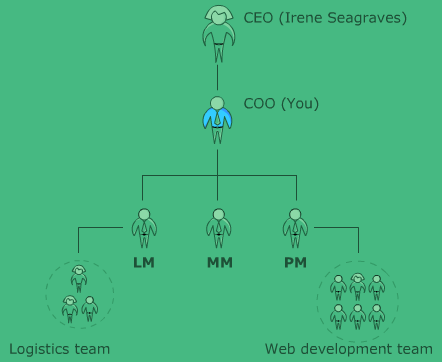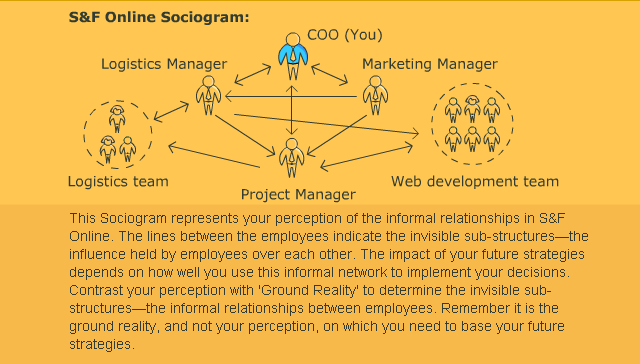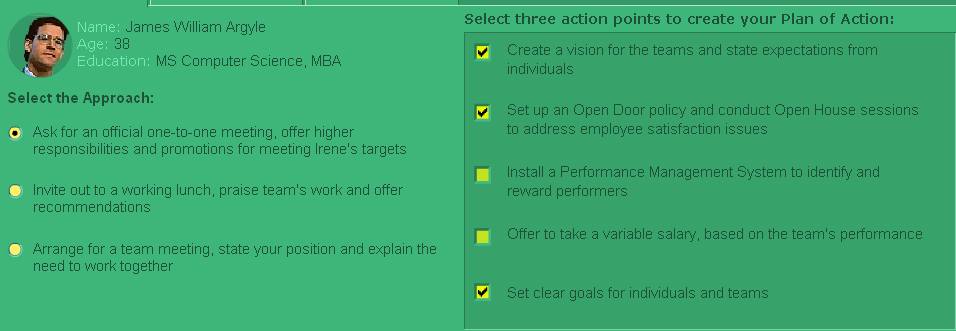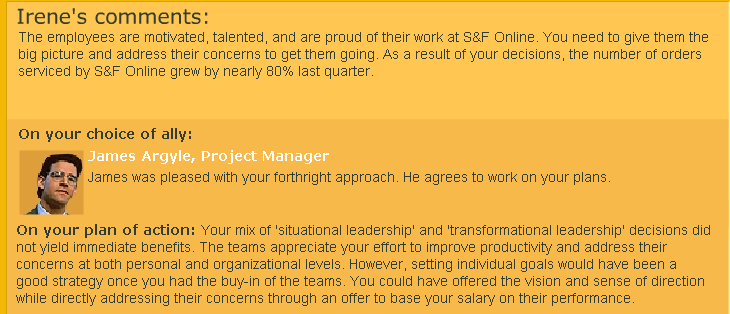Established methods of control
Smith & Falmouth – S&F is in the business of tele-shopping and mail order network. The company has started an e-tailing division that is important for the company’s growth plan. There is already a web development team, a logistics team and a marketing manager. The project manager handles the whole project. He controls the six member web development team that maintains the online sales channel made up of the website and the online payment gateway. PM works with logistics manager and his three-member logistics team that manages order handling, customer support and delivery operations. The team also reports order fulfillment status to Marketing Manager who coordinates product lines, marketing budgets and promotional activities. I as the COO have to increase the reach of the online sales channel and make S&F as a profitable strategic unit within 9 months.

The project manager maintains control over the web development team who values teamwork and builds personal rapport with each colleague. He dislikes interventions that restrict his power over the carefully nurtured teams. Brain uses sheer effort and involvement with the team with whom he interacts comfortably. He is interested in technology and tracks solutions implemented by the web development team. Smith the marketing manager manages his relations with key players but does not interact much with the teams. He uses a direct gung ho approach that sometimes intimidates close-knit groups such as the web development team.
Current culture of department and organization
The current culture of S&F is riddled with groups and sub groups and each group has its own rules and informal ways of dealing with people and putting them in place. When the new COO takes over, the reactions of other groups and leaders is very lukewarm and it is obvious that they are not going to cooperate whole heartedly, unless the leader of the groups shows some change in behavior. Their leaders dominate the groups. Earlier the PM, LM and MM were directly in touch with the CEO. With the introduction of the new COO, all these three leaders would have to report to the COO and not directly to the CEO. This means a certain amount of ‘demotion’ in their perceived roles. The groups of web development team and the Logistics team are not very open and amenable to accepting new members into their close-knit groups and group members would fiercely resist all attempts by the COO to integrate with the teams. The COO has realized after the second week that there are different groups and cliques in the organization that go beyond the formal organizational structure. The COO cannot operate by himself and manage all the tasks independently. He needs to have the support of the teams and individual members. To achieve this, he has to win over the decision makers in the informal groups. The influential members are the PM, LM and the MM. Out of these, the PM is the most influential since he controls six web developers. So the key ally to be made in this exercise is the project manager.
Recommendation for restructuring the department
The relationships recommended for restructuring the department are as given in the following figure.

It is proposed that a two way communication and direction should be established with the three managers, PM, LM and MM. One of the managers has to be selected as the principal ally and the PM was selected since he is the most influential, commands six members of the web development team and other managers refer to him to check on the progress of the project. The PM is rather upset with the COO because he perceives that with the appointment of the COO, his own position has become secondary. To break the ice and ensure cooperation, the COO invites the PM for a working lunch and offers a promotion and rise in salary, status, if the project is completed as required and this is appreciated by the PM. Other lines of the sociogram are indicated in the above figure. The PM has a two-way relation with the web development team and the LM and MM both direct relations towards the PM. There are no direct relations proposed for the COO with the web development team at this stage. The marketing manager and logistics manager have a direct both way relation with the COO and the LM has two-way relation with his logistics management team but not with the web development team. The marketing manager restricts his relations to only the PM and LM and he has no direct contact with the individual team members. It is assumed that once the PM has been mollified, he would in turn make the COO more acceptable to other managers and the web development team that is crucial
Which Effective Management Practice
The simulation starts operating after the sociogram has been finalized. Next the PM is selected as an ally and ‘Ask for an official one to one meeting, offer higher responsibilities and promotions for meeting Irene’s targets’ option is selected. Once this is finalized then the next selection are shown in the following figure.

As shown in the above figure, to solve the problem of the shopping cart, three selections are made and they are: “create a vision for the teams and state expectations from individuals; set up an open door policy and conduct open house sessions to address employee satisfaction issues and set clear goals for individuals and teams”. The results are good and both Irene and the PM are satisfied as seen in the following feedback.

As seen in the above figure, number of orders serviced has risen up by 80% and the PM is happy with the approach. The next challenge comes from Irene who wants to double the current customer base and new people have to be hired. This move is regarded with fear by other members who feel threatened and are very hostile towards the new team members. This calls for a different two set of actions and these are shown as below.

The second set of actions is given as below.

These actions are designed to bring the best out of people and motivate them to achieve their tasks. When more skills were required, the COO hired new people. To allay fears of the older members that they would be sidelined, the COO motivated the people to work better and harder with cooperation. The results were very positive, as seen in the following figure.

As seen in the above figure, the plan of action has been successful and Irene, the CEO is happy with the performance. She herself has been promoted to the board of directors and has promoted the COO to take her place as the CEO. Now it remains to be seen if the PM would be promoted as the COO and further promotions would have to follow.
How Size and new structure affects organization and People
The new structure aims at creating an ally with the PM who has been promised a promotion and salary increase if the targets are met. The COO realized that directly interacting with the web development team and attempting to break the socio groups would not be very productive. Therefore, by selecting the PM as an ally, the COO has got the loyalty of the web development team. The new structure therefore attempts to create sub links between the PM and the COO so that better relations are developed. During the simulation there was a problem that new people had to be recruited with different and enhanced skills. The current employees felt threatened that the new recruits would gain more importance and that their roles would be diminished. To prevent isolation of the new recruits, the COO decided to have a career development plan for them that would offer training, mentoring and the chance to develop new skills. The move as obviously paid off as the new recruits have been accepted by the old socio group of the web development and full cooperation has been extended. This happened because the COO put into place a plan that would take care of the career aspirations of all employees and help them to grow.
References
Affecting Change Simulation.exe, 2009. Simulation for the Affecting Change case for S&F. Phoenix University, Phoenix, USA.